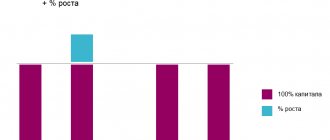During the 90s of the last century, many Western money management tools came into Russian investment practice. One of these instruments is mutual investment funds (UIFs), which have become widespread: at the moment, over a thousand similar structures operate on Russian territory.
Let us outline the main characteristics of such an object as a mutual fund. In accordance with the law on mutual investment funds (Federal Law of November 29, 2001 N 156-FZ “On Investment Funds”), a mutual investment fund is not a legal entity; it is a property complex, the assets of which consist of the property of the founders, who have transferred it under the management of a specialized company ( Management Company), and property received as a result of the investment activities of the management company. Thus, the property that makes up a mutual investment fund is the collective property of the participants (shareholders) of the mutual fund. Moreover, according to the law, the shareholder cannot receive his share in kind, but has the right to demand its repayment and payment of compensation only in cash equivalent.
Types of mutual funds: open, interval and closed mutual investment fund
Depending on the ability of shareholders to make a claim for redemption of shares, all mutual investment funds are divided into types: open, interval and closed mutual funds. Owners of open-end fund units may demand their redemption on any business day; shareholders of interval funds have the right to withdraw from the funds only during certain periods (intervals) established by the rules of trust management of the fund; Shareholders of closed-end mutual funds cannot redeem their shares before the end of the fund's life, with the exception of a number of cases established by law. Moreover, since the investment share is a security, the owner has the opportunity to sell it at any time. The difference between the sale of a share and its redemption is that the latter leads to a decrease in the fund’s assets, because compensation is paid from the mutual fund’s property, and the sale of a share does not affect the fund’s volume.
Creating a mutual fund - brief instructions for investors
The most important thing you need to know when establishing a mutual fund is that in the general legal sense, a mutual fund is not a legal entity and all its property (funds of shareholders) is managed by special management organizations (management companies) on the basis of a trust management agreement. Therefore, the very initial stage of the formation of a mutual fund will be the creation by its founders of the “Rules for the trust management of a mutual investment fund.”
In essence, this is the Foundation’s Charter, and it must contain:
- Goals and duration of the fund (for example, a fund for investing in promising technologies for producing energy using the sun)
- Investment declaration - investment strategy, tools for investing capital, ways to manage it
- Selecting a management company and an agreement with it
Actually, the procedure for creating a mutual fund may look like this:
- State registration of the fund's PDU - submission of a package of documents (personal data of the founders, application and the PDU themselves) to the Federal Financial Markets Service of the Central Bank. Registration period is no more than 30 days.
- Approval of regulatory documents (Regulations for recognizing persons as qualified investors, rules for internal accounting of property transferred as payment for investment shares, accounting policies for mutual funds, rules for determining the value of net assets of a mutual fund, policies for exercising voting rights on shares included in the mutual fund).
- Accreditation of qualified investors (if the mutual fund is created for qualified investors)
- Opening a transit account (depository account) of a management company for the formation of a mutual fund - this must be done immediately after registering the PFU, but before the start of accepting funds from retail investors
- Opening a current account for the management company of a mutual fund is carried out after registration of the PDU by the Fund and before the start of accepting applications for the purchase of investment shares
- Opening a management account for settlements on management operations
- Opening a custody account for a management company for storing mutual fund securities
- Opening of personal accounts for purchasers of mutual fund investment units
- The inclusion of assets in the mutual fund is carried out immediately after the receipt of tangible assets in payment for investment shares necessary to complete the formation of the Fund.
- Issuance of investment units of a mutual fund to investor-depositors - this operation is carried out either on the very day the property is included in the mutual fund, or on the next business day.
- Approval of the report on the completion of the formation of the mutual fund is carried out no later than 5 working days from the date of issuance of investment units to investors
- Submission of the report and changes to the mutual fund management system to the Financial Markets Service of the Central Bank of the Russian Federation - no later than 5 working days from the date of issuance of investment units
- State registration of changes in the mutual fund PDU - is carried out within 5 working days from the date of submission of documents to the Federal Financial Markets Service of the Central Bank of the Russian Federation
- Publication of changes or notification of registration of changes in the PDU by the Fund to depositors - investors (who own an investment share) - this procedure is carried out within 10 working days from the date of notification of the Financial Markets Service of the Central Bank of the Russian Federation about the registration of changes to the rules of trust management.
The entire presented methodology for registering a mutual fund (as well as other types of collective investment organizations) is presented as required by the main regulatory document relating to the work of mutual funds, namely Order of the Federal Financial Markets Service of Russia dated 04/09/2013 N 13-25/pz-n, as well as the Civil and Tax Codes of the Russian Federation.
Despite the relatively simple procedure for registering a mutual fund, it should still be recognized that in Russian realities one cannot do without specialists and professionals in the field of corporate law. And if there is such an opportunity, it always makes sense to contact specialized law or consulting firms that know how to create investment funds, will help you create a package of registration documents and go through all stages of registration with the least loss of time and money.
Categories of mutual funds
In addition to the above classification, mutual funds are divided into categories depending on the composition of eligible assets. Until December 18, 2016 the legislation provided for 16 categories of funds: money market funds, bond funds, stocks, mixed investments, closed-end mutual funds of direct and long-term direct investments, closed-end mutual funds of especially risky (venture) investments, closed-end mutual funds of funds, rental funds and real estate funds (closed-end rental and closed-end real estate mutual funds), mortgage, index, credit funds (credit closed-end mutual fund), commodity market funds, hedge funds, as well as artistic property funds (closed-end artistic property fund). At the same time, the law established the following permissible combinations of types and categories of mutual investment funds:
| Categories | OPIF | IPIF | Closed mutual fund |
| Money market mutual fund | + | + | + |
| Mutual fund of shares | + | + | + |
| Mutual Fund of bonds | + | + | + |
| Mutual investment fund of mixed investments | + | + | + |
| Mutual fund for especially risky (venture) investments | — | — | + |
| Direct investment mutual fund | — | — | + |
| Mutual fund for long-term direct investments | — | — | + |
| Mortgage mutual fund | — | — | + |
| Rental mutual fund | — | — | + |
| Real estate mutual fund | — | — | + |
| Credit mutual fund | — | — | + |
| Commodity market mutual fund | — | + | + |
| Hedge mutual fund | — | + | + |
| Mutual fund of artistic values | — | — | + |
| Mutual Funds | + | + | + |
| Index mutual fund | + | + | + |
However, Directive of the Bank of Russia dated September 5, 2016 N 4129-U “On the composition and structure of assets of joint-stock investment funds and assets of mutual investment funds” significantly simplified the structure of the collective investment market. So, in particular, the number of categories of investment funds has been significantly reduced: for qualified investors - from 15 to 3 (financial instruments funds, real estate funds, combined funds), for unqualified investors - from 7 to 2 (market financial instruments funds and real estate funds).
| Categories of mutual funds | Types | Limitation of shares in circulation | |||
| OPIF | IPIF | Closed mutual fund | For qualified investors | For unqualified investors | |
| Mutual fund of market financial instruments | + | + | + | + | |
| Mutual Fund of Financial Instruments | + | + | + | ||
| Real estate mutual fund | + | + | + | ||
| Combined mutual fund | + | + | + | ||
How to open an investment fund: answers to your questions
In this section, we have collected the points that have accumulated over many years and arouse the greatest interest of our clients. But we ask you to remember that the information presented below should not be taken as a direct guide to action or a set of instructions in the How To format. If you need specific assistance, agree on the terms of an individual consultation with our experts (e-mail).
Is it true that the main task of an investment fund is to invest funds in the most interesting and promising projects?
True, but only partially. In fact, any IF is built on an inextricable link between two tasks - investing in specific projects and extracting the maximum possible benefit in the context of collective investments. If someone tells you that the entire economy is based on IFs, do not believe it. The modern world order is much more complex.
What are the main benefits of group investing?
There are quite a lot of them, and they are obvious and indisputable. But – an important note – they are by no means universal. In other words, the pros in one case can easily turn into a bunch of disadvantages in another. It all depends on many individual characteristics and requires careful consideration at the planning stage.
General benefits:
- If you know how to open an investment fund, have a ready-made project and real goals, but lack financial resources, a common pool of funds will be very helpful.
- You can resort to the services of specialists and involve them in the work. The amount required to pay for their work will be divided among all participants.
- Slightly lower transaction costs (if the investment fund has a small effect, the effect will be particularly pronounced).
- An increased level of asset diversification, which allows you to reduce (but not reduce them to zero!) risks that cannot or are very difficult to predict.
- Attracting financial reserves from third parties (there are legal and organizational restrictions).
- Profit is calculated based on the invested funds.
What is the classification of investment funds?
To fully answer this question, you need a fairly large text with infographics, links to current regulations and a significant analytical block. We doubt that such information can be of practical use, so we will limit ourselves to only the most common options.
IF options:
- By format: mutual funds, ETFs, hedges.
- Where possible, third-party participation: open, closed (in the latter cases, shares are distributed only when the fund is created).
- By place of registration (reference): onshore, midshore and pure offshore.
How to open an investment fund and not make a mistake with the structure?
The worst thing you can do is really start guessing. Projects of this level, as we have said more than once, require calculation and analysis of all possible options. We strongly recommend that you involve our experts in this. At least at the preliminary stage. Regarding the question asked, we can say the following: each jurisdiction has its own special rules, but the general elements that are almost always present do not change.
"Required" persons:
- The beneficiary influences the IF . He is also called a promoter, owner or founder. Let us clarify that this role can be played by both legal entities and individuals.
- Shareholders , or investors . Based on their investments, a common financial pool is created.
- Management company or individual manager.
- Custodian , or depositary . Its functions include actual accounting of assets and maintaining the appropriate register. Most often, these tasks are performed by a legal entity that has a special license, or directly by the bank.
- Registrar . An organization tasked with actually carrying out transactions in IF shares.
- Lawyer (law firm) . In charge of maintaining documentation.
- Broker . Trades shares on the stock exchange.
I didn’t know how to open an investment fund, and they advised me to have a mutual fund. This is right?
You should stay as far away from such “advisers” as possible. Let's say there: the recommendation is not completely meaningless, and even moreover, it is probably correct. But without knowing your specific situation, it is unprofessional to give such advice. In other words, if you are recommended to buy, say, a solid Mercedes or Audi, but you need the car to transport potatoes from the dacha... Well, you understand.
Secondly, you were interested in the opening procedure, and not the legal form of the investment fund. And these are completely different things. Thirdly, in some cases it makes sense to consider other, alternative options not related to IF at all, and they will be a better choice. But, we repeat, in this specific situation. But in order not to end the answer to the reader’s question on a minor note, we will describe the most important points regarding mutual funds (unit funds / mutual investment funds). Which are indeed the most popular format, although far from the only possible one.
Note:
- Does not have the status of a legal entity.
- The right to dispose of assets belongs to the management structure, the work of which, in turn, is controlled by the owner of the fund.
- The supervisory authority is the national financial regulator of the jurisdiction where the mutual fund is registered.
- To create a mutual fund, you definitely need “your own” investors.
- Structures for managing the fund can be registered independently.
- Placement of shares in the depository is mandatory.
What goals and benefits are pursued when creating private investment funds? Just making a profit?
Of course not. The general informal rule is: if you know how to open an investment fund, then you understand why it is actually needed. But quite often there is a situation when it is necessary to solve a specific problem, and the question arises of choosing the appropriate means to achieve this. And in this case, talking about the features and purposes of IF will be quite appropriate.
Problems that an investment fund can solve:
- Attracting additional financial resources.
- Safe (with certain reservations) investment with a minimum of risk. The legal structure of the mutual fund itself should be thanked for this.
- Optimization of the tax burden.
- Merger (integration) of the fund and other existing business.
We will separately highlight the benefits for beneficiaries:
- An effective collective investment tool. It should be considered first if you are planning a large and complex project that requires extended financing.
- A certain status component.
- Significant reduction of the distance between the owners of funds (investors), persons who need financing and beneficiaries of the fund.
- Formalization and legitimization of legal relations with investors.
- Increased asset protection.
- Preliminary approval of the details of the transaction before its actual execution.
- Significant tax savings.
How to open an investment fund?
It is pointless to talk about specifics without knowing the type of fund, the jurisdiction where it will be located, the assigned tasks and the amount, at least approximately, of financial resources. Therefore, we will talk about the main, basic stages that are almost always present.
Creation stages:
- Adaptation of a standard project for a specific fund.
- Development of management principles and rules.
- State registration.
- Direct formation of a financial pool.
What are they - index or commodity funds?
In fact, it is a good, although not universal, alternative to traditional investment funds. Index (or ETF - Exchange Traded Fund) “live” on stock indices, or on any raw materials. Compared to classic mutual funds, they have two undoubted advantages: profitability and investment attractiveness, since ETF shares are traded on exchanges.
Economic essence
What is a mutual fund in simple words? This is an option for pooling the funds of individual investors “in a single pot” and trust management (MA) of them by professional managers of a management company (MC). Ideal goal: to ensure permanent growth in asset value.
As follows from the definition, the fund is filled with the money of individual investors, each of whom becomes a shareholder - the owner of a certain number of shares.
An investment share is a registered document indicating the investor’s ownership of a share in the property, and gives the investor guaranteed rights:
- the right to competent management of one's savings;
- for any mutual funds: the right to return your share in cash upon closure of the fund (termination of the trust agreement with all investors);
- for open mutual funds: the right to redeem their securities at any time;
- for closed mutual funds (only if expressly stated in the rules): the right to redeem their securities at a certain moment, the right to receive regular income from the trust (analogous to dividends), the right to participate in a meeting of shareholders.
In practice, shares of a closed-end mutual fund are converted into cash only at closing. To ensure the liquidity of shares, the management company in some situations ensures exchange circulation of securities.
Important. Unlike a share (key equity security), an investment unit: does not have the status of an issue-grade security; issued only in undocumented form; has no nominal value; does not allow the issuance of its derivatives.
The number of securities of an open and interval mutual fund can be as large as desired; closed mutual fund - limited by the rules of the management agreement.
How is the value of an investment share calculated? As the quotient of the fund's net assets divided by the number of issued units. Net assets are all property at the time of settlement minus the debt obligations of the management company to infrastructure participants.
Obviously, the price of one share is a dynamic value that changes daily (it increases when the portfolio becomes more expensive and decreases when it becomes cheaper).
Useful video about what a mutual fund is.










